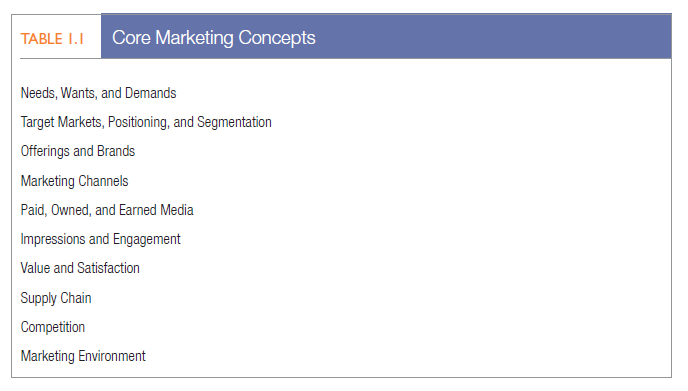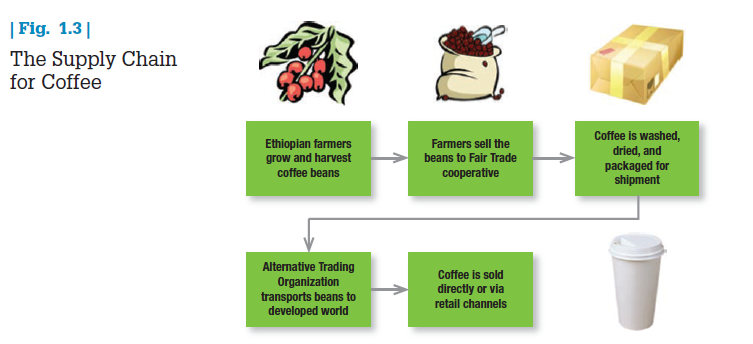To understand the marketing function, we need to understand the following core set of concepts (see Table 1.1).
1. NEEDS, WANTS, AND DEMANDS
Needs are the basic human requirements such as for air, food, water, clothing, and shelter. Humans also have strong needs for recreation, education, and entertainment. These needs become wants when directed to specific objects that might satisfy the need. A U.S. consumer needs food but may want a Chicago-style “deep-dish” pizza and a craft beer. A person in Afghanistan needs food but may want rice, lamb, and carrots. Our wants are shaped by our society.
Demands are wants for specific products backed by an ability to pay. Many people want a Mercedes; only a few can buy one. Companies must measure not only how many people want their product, but also how many are willing and able to buy it.
These distinctions shed light on the criticism that “marketers get people to buy things they don’t want.” Marketers do not create needs: Needs pre-exist marketers. Marketers might promote the idea that a Mercedes satisfies a person’s need for social status. They do not, however, create the need for social status.
Some customers have needs of which they are not fully conscious or cannot articulate. What does the customer mean in asking for a “powerful” lawn mower or a “peaceful” hotel? The marketer must probe further. We can distinguish five types of needs:
- Stated needs (The customer wants an inexpensive car.)
- Real needs (The customer wants a car whose operating cost, not initial price, is low.)
- Unstated needs (The customer expects good service from the dealer.)
- Delight needs (The customer would like the dealer to include an onboard GPS system.)
- Secret needs (The customer wants friends to see him or her as a savvy consumer.)
Responding only to the stated need may shortchange the customer.17 Consumers did not know much about tablet computers when they were first introduced, but Apple worked hard to shape consumer perceptions of them. To gain an edge, companies must help customers learn what they want.
2. TARGET MARKETS, POSITIONING, AND SEGMENTATION
Not everyone likes the same cereal, restaurant, university, or movie. Marketers therefore identify distinct segments of buyers by identifying demographic, psychographic, and behavioral differences between them. They then decide which segment(s) present the greatest opportunities. For each of these target markets, the firm develops a market offering that it positions in target buyers’ minds as delivering some key benefit(s). Volvo develops its cars for the buyer to whom safety is a major concern, positioning them as the safest a customer can buy. Porsche targets buyers who seek pleasure and excitement in driving and want to make a statement about their wheels.

3. OFFERINGS AND BRANDS
Companies address customer needs by putting forth a value proposition, a set of benefits that satisfy those needs. The intangible value proposition is made physical by an offering, which can be a combination of products, services, information, and experiences.
A brand is an offering from a known source. A brand name such as Apple carries many different kinds of associations in people’s minds that make up its image: creative, innovative, easy-to-use, fun, cool, iPod, iPhone, and iPad to name just a few. All companies strive to build a brand image with as many strong, favorable, and unique brand associations as possible.
4. MARKETING CHANNELS
To reach a target market, the marketer uses three kinds of marketing channels. Communication channels deliver and receive messages from target buyers and include newspapers, magazines, radio, television, mail, telephone, smart phone, billboards, posters, fliers, CDs, audiotapes, and the Internet. Beyond these, firms communicate through the look of their retail stores and Web sites and other media, adding dialogue channels such as e-mail, blogs, text messages, and URLs to familiar monologue channels such as ads.
Distribution channels help display, sell, or deliver the physical product or service(s) to the buyer or user. These channels may be direct via the Internet, mail, or mobile phone or telephone or indirect with distributors, wholesalers, retailers, and agents as intermediaries.
To carry out transactions with potential buyers, the marketer also uses service channels that include warehouses, transportation companies, banks, and insurance companies. Marketers clearly face a design challenge in choosing the best mix of communication, distribution, and service channels for their offerings.
5. PAID, OWNED, AND EARNED MEDIA
The rise of digital media gives marketers a host of new ways to interact with consumers and customers. We can group communication options into three categories.18 Paid media include TV, magazine and display ads, paid search, and sponsorships, all of which allow marketers to show their ad or brand for a fee. Owned media are communication channels marketers actually own, like a company or brand brochure, Web site, blog, Facebook page, or Twitter account. Earned media are streams in which consumers, the press, or other outsiders voluntarily communicate something about the brand via word of mouth, buzz, or viral marketing methods. The emergence of earned media has allowed some companies, such as Chipotle, to reduce paid media expenditures.19
6. IMPRESSIONS AND ENGAGEMENT
Marketers now think of three “screens” or means to reach consumers: TV, Internet, and mobile. Surprisingly, the rise of digital options did not initially depress the amount of TV viewing, in part because, as one Nielsen study found, three of five consumers use two screens at once.20
Impressions, which occur when consumers view a communication, are a useful metric for tracking the scope or breadth of a communication’s reach that can also be compared across all communication types. The downside is that impressions don’t provide any insight into the results of viewing the communication.
Engagement is the extent of a customer’s attention and active involvement with a communication. It reflects a much more active response than a mere impression and is more likely to create value for the firm. Some online measures of engagements are Facebook “likes” Twitter tweets, comments on a blog or Web site, and sharing of video or other content. Engagement can extend to personal experiences that augment or transform a firm’s products and services.
7. VALUE AND SATISFACTION
The buyer chooses the offerings he or she perceives to deliver the most value, the sum of the tangible and intangible benefits and costs. Value, a central marketing concept, is primarily a combination of quality, service, and price (qsp), called the customer value triad. Value perceptions increase with quality and service but decrease with price.
We can think of marketing as the identification, creation, communication, delivery, and monitoring of customer value. Satisfaction reflects a persons judgment of a products perceived performance in relationship to expectations. If performance falls short of expectations, the customer is disappointed. If it matches expectations, the customer is satisfied. If it exceeds them, the customer is delighted.
8. SUPPLY CHAIN
The supply chain is a channel stretching from raw materials to components to finished products carried to final buyers. As Figure 1.3 shows, the supply chain for coffee may start with Ethiopian farmers who plant, tend, and pick the coffee beans and sell their harvest. If sold through a Fair Trade cooperative, the coffee is washed, dried, and packaged for shipment by an Alternative Trading Organization (ATO) that pays a minimum of $1.26 a pound. The ATO transports the coffee to the developed world where it can sell it directly or via retail channels. Each company in the chain captures only a certain percentage of the total value generated by the supply chain’s value delivery system. When a company acquires competitors or expands upstream or downstream, its aim is to capture a higher percentage of supply chain value.
Problems with a supply chain can be damaging or even fatal for a business. When Johnson & Johnson ran into manufacturing problems with its consumer products unit (which makes Tylenol and other products), it hired away from Bayer AG a top executive known for her skill at fixing consumer and supply chain problems.21

9. COMPETITION
Competition includes all the actual and potential rival offerings and substitutes a buyer might consider. An automobile manufacturer can buy steel from U.S. Steel in the United States, from a foreign firm in Japan or Korea, or from a mini-mill such as Nucor at a cost savings, or it can buy aluminum parts from Alcoa to reduce the car’s weight or engineered plastics from Saudi Basic Industries Corporation (SABIC) instead of steel. Clearly, U.S. Steel is more likely to be hurt by substitute products than by other integrated steel companies and would be defining its competition too narrowly if it didn’t recognize this.
10. MARKETING ENVIRONMENT
The marketing environment consists of the task environment and the broad environment. The task environment includes the actors engaged in producing, distributing, and promoting the offering. These are the company, suppliers, distributors, dealers, and target customers. In the supplier group are material suppliers and service suppliers, such as marketing research agencies, advertising agencies, banking and insurance companies, transportation companies, and telecommunications companies. Distributors and dealers include agents, brokers, manufacturer representatives, and others who facilitate finding and selling to customers.
The broad environment consists of six components: demographic environment, economic environment, social-cultural environment, natural environment, technological environment, and political-legal environment. Marketers must pay close attention to the trends and developments in these and adjust their marketing strategies as needed. New opportunities are constantly emerging that await the right marketing savvy and ingenuity. Consider Pinterest.22
PINTEREST One of the fastest-growing social media sites ever-its surpassed 10 million monthly unique U.S. visitors in January 2012 and doubled that just four months later-Pinterest is a visual bookmarking tool that lets users collect and share images of projects or products on digital scrapbooks or “pinboards.” Especially popular with women planning weddings, saving recipes, and designing kitchen upgrades, Pinterest has driven more traffic to websites in a month than Twitter, Google+, LinkedIn, and YouTube combined. Part of its appeal is its unique customizable grid of images. Pinterest’s sweet spot is that users are often in a shopping mindset; one study showed almost 70% of online purchasers who found a product via Pinterest went on to buy, compared to 40% for Facebook. Brands from Dell and Mercedes-Benz to Peanut Butter & Co. and Zombie SAK are integrating the site into their social media strategies. Nevertheless, Pinterest is still exploring how to best monetize its business venture.
Source: Kotler Philip T., Keller Kevin Lane (2015), Marketing Management, Pearson; 15th Edition.

There is noticeably a bundle to know about this. I assume you made certain nice points in features also.